How To Choose The Correct Pond Pump
Choosing a pump for your pond or fountain is a crucial step to ensure you maintain proper water movement. Failure to keep the water adequately circulated can result in stagnation, algae buildup, and mosquitoes. In addition, if you have fish, plants, or other aquatic life in your pond, you must keep the water healthy by evenly distributing the oxygen levels and other nutrients.
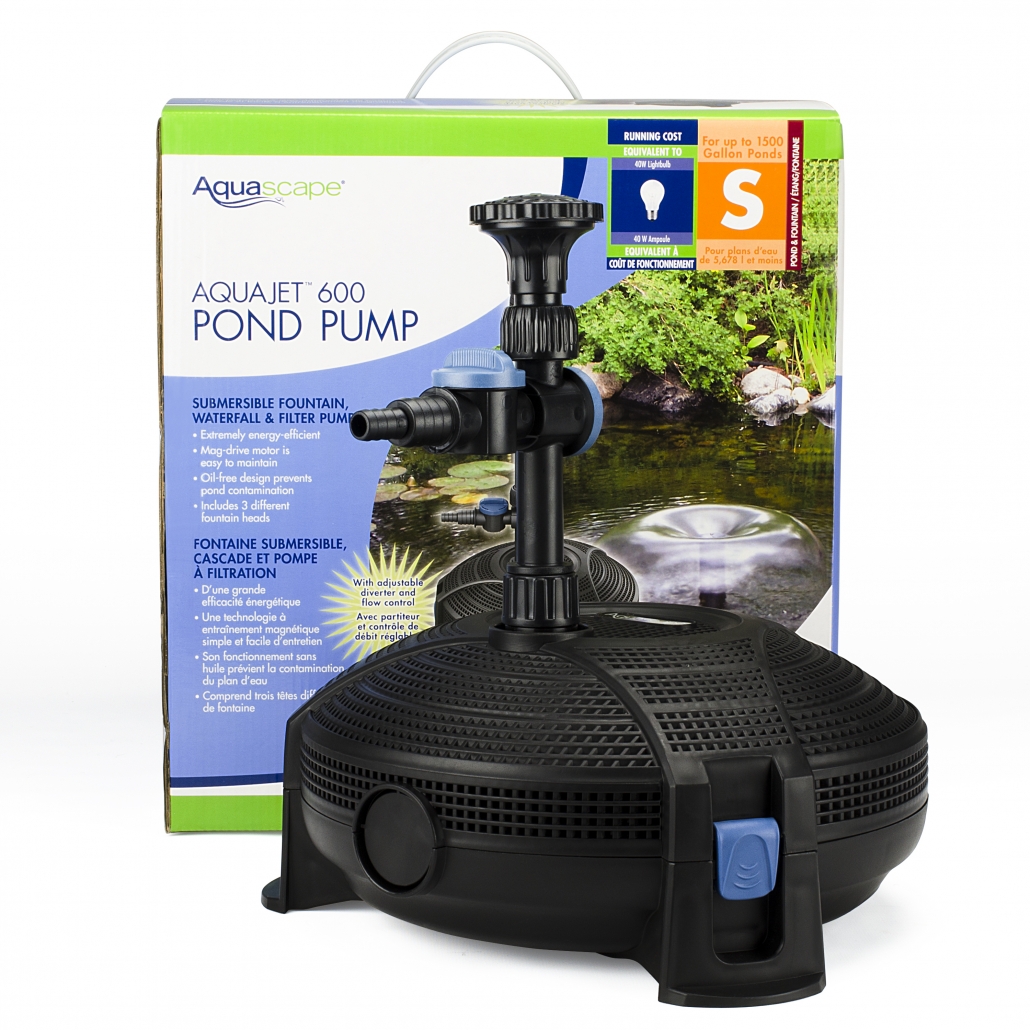
Types of Pond Water Pumps
There are two main types of pond water pumps: submersible and external (out-of-pond), also known as centrifugal pumps. Depending on the application, each pump offers specific advantages.
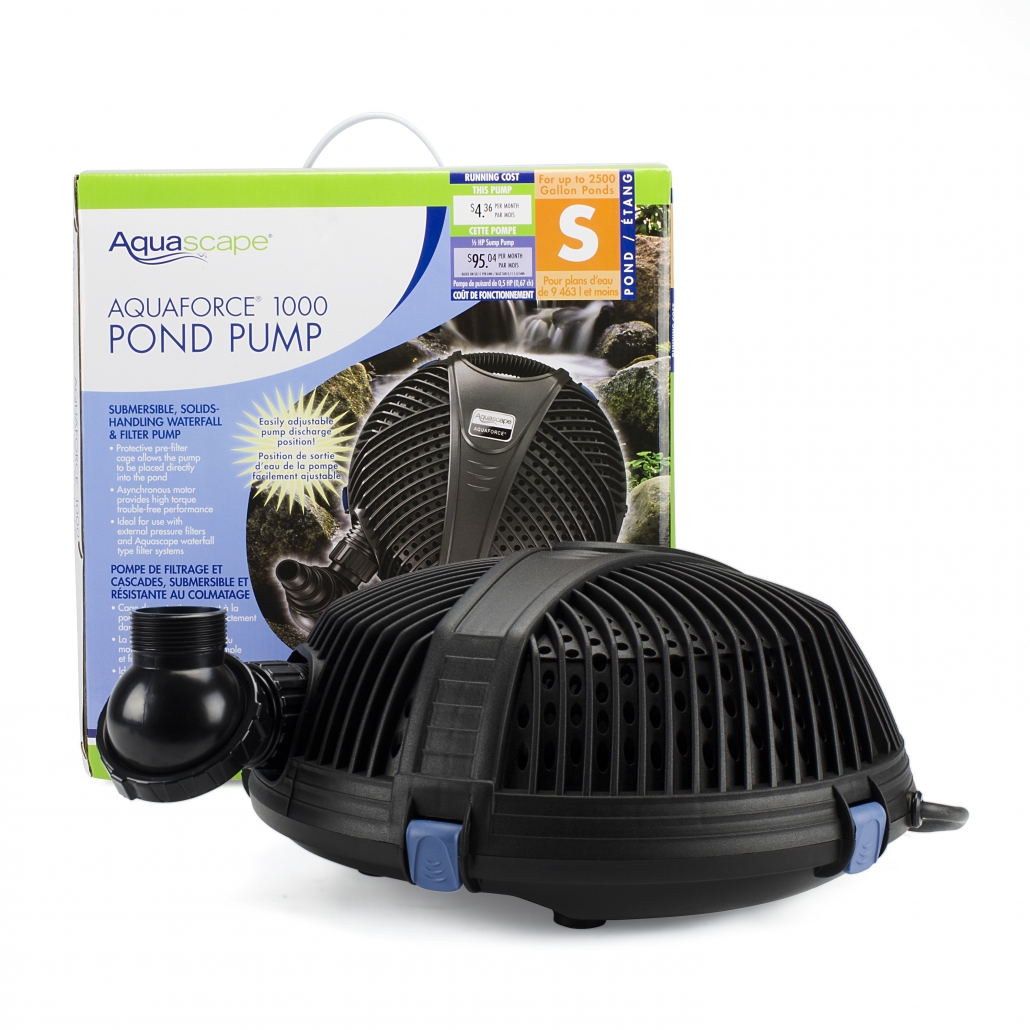
Submersible Pond Pumps
Submersible pumps are designed to be fully submerged underwater at the deepest part of the pond. They are placed directly into your pond or in a skimmer box or pond vault. Submersible pumps range in size from 50 to 5,000 gallons per hour. They are easy to install and are sometimes a more economical solution for smaller ponds (up to 1000 gallons of water). They are also quiet and can also be used to drain your pond. If you have fish or other aquatic life in your pond, you may want to consider a model that does not use oil because there is a danger of the pump seal breaking and oil coolant leaking into the water.
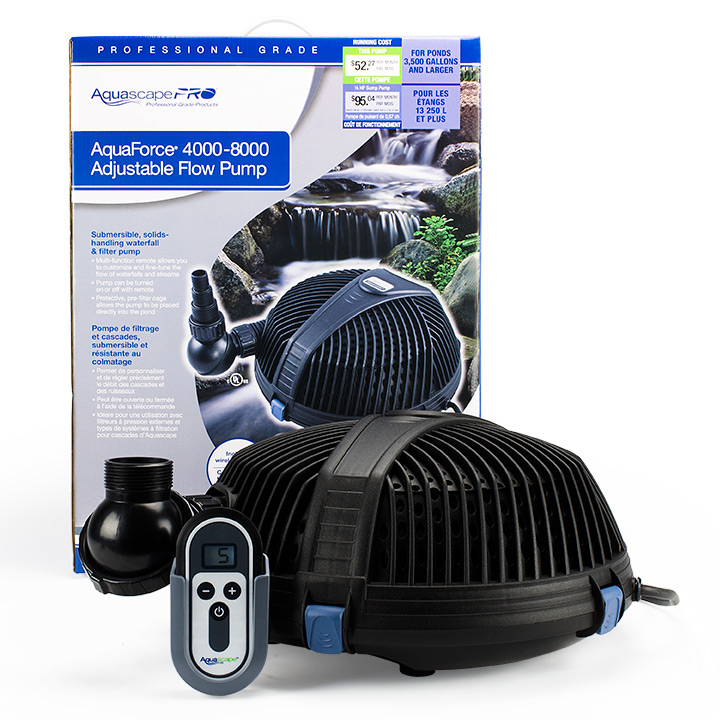
Centrifugal Pond Pumps
External or centrifugal pond pumps are a reliable, energy-efficient option. They are installed in a dry location near your pond. External pond water pumps are suitable for larger ponds (over 1000 gallons). Compared to a submersible pump, they are typically louder and more complicated to install; however, they are easier to maintain.
When selecting a pond pump, it’s essential to keep in mind that pumps have different cord lengths. Ensure the cord is long enough to go through the pond and plugin far away from the water. Some electrical codes specify that the outlet for water features must be at least 6 feet away from the water. Therefore, it is recommended that you avoid using an extension cord. However, if you must use one, make sure it’s suitable for outdoor use and plugged into a ground fault circuit interrupter (GFCI) so that it will immediately shut off if there is an overload.

How to Size a Fountain or Pond Pump
Pond pumps are sized by gallons per hour (GPH) at one foot of lift or height. Larger capacity pumps are rated by horsepower (HP). To determine the size pond pump, first, you need to calculate the volume of water in the pond. To calculate the volume of water in gallons, multiply the length x width x average depth x 7.5.
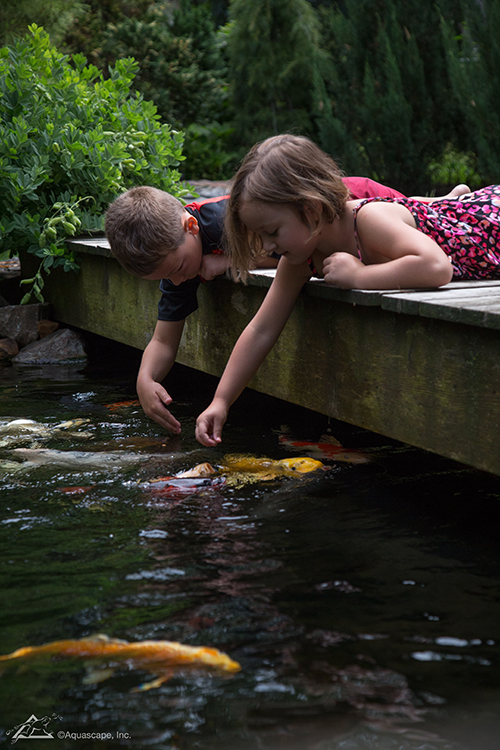
Water Circulation Factors
It is recommended that pond water is circulated at least once per hour. For example, if you have a 500-gallon pond, you need a pump that runs 500 gallons per hour at the discharge height. If your pond has a pressurized filter, you ideally want to turn the water approximately once every two hours. For example, if you have a 1000 gallon pond, you need a pond pump rated at a minimum of 500 GPH. If your pond has a skimmer or waterfall, the water should be turned approximately once every hour. Therefore, if you have an 1800 gallon pond, you will need an 1800 GPH rated pump.
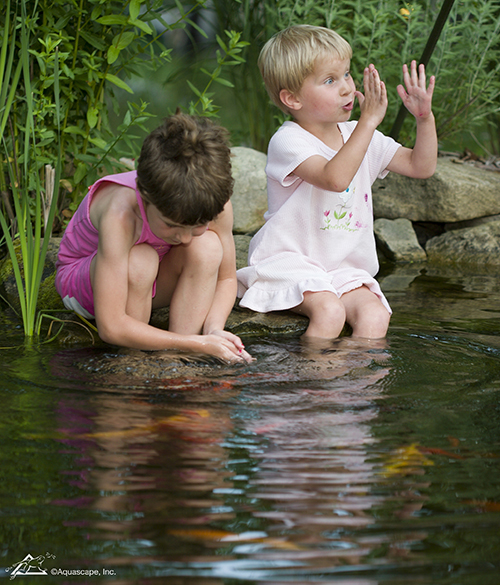
Calculating Head and Lift Height
Two of the most critical measurements in sizing a pond or fountain pump are the maximum head height rating and maximum lift. Head height means the vertical height the pump raises water above the surface of the pond. The pond fountain pump’s top height can lift the water to is called “Maximum Head” or “Max Head.” The “Head” is measured straight up from the water level of the pond. Its length then measures any horizontal/diagonal flow, and 1′ of “Head” added per 10′ of horizontal/diagonal distance. To calculate the lift, you need to measure how far the water in your fountain has to travel from the pump’s location in your rush to the top of the fountain where the water comes out. Then you need to select a pump that lifts higher than that measurement. For example, if that distance is 24”, than you will need a fountain pump that lifts at least 36” tall. The “maximum lift” is the maximum height that the pump will raise the water.
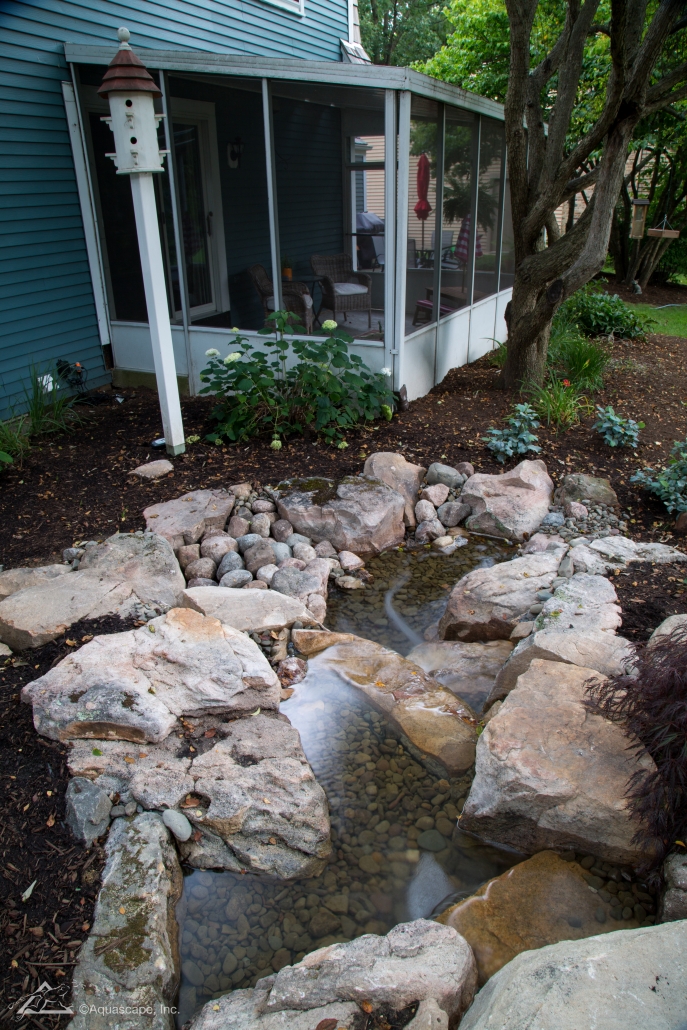
Selecting the Proper Pond Water Pump Tubing
It is also essential to use the correct tubing size because it directly affects the pond pump‘s maximum lift capability. If you use smaller tubing than specified, you will limit the pump’s maximum lift and the amount of water circulated.
Choosing the right pond water pump for your pond or fountain requires careful consideration and a little upfront research. However, doing so will go a long way toward keeping your water clean and healthy and your pump operating efficiently.
Sensor-Driven Water Features
Sensor-driven water features are redefining the way we experience outdoor spaces. By integrating intelligent technology into traditional water displays, these innovative installations create dynamic environments that respond to changes in light, motion, and even temperature. This blend of art and automation not only enhances the aesthetic appeal of your garden but also contributes to energy efficiency and sustainability. 💧
The Power of Sensor Technology
At the heart of sensor-driven water features are advanced sensors that monitor environmental conditions in real time. These devices detect subtle changes—such as a drop in ambient light at dusk or the presence of movement in your garden—and trigger responses that elevate your water display. For instance, motion sensors can activate a gentle burst of water as you pass by, creating an interactive and engaging experience. Similarly, light sensors adjust the intensity of LED lighting to highlight the feature’s best angles as the day transitions to night.
Enhancing User Experience and Efficiency
One of the most significant advantages of sensor-driven water features is the convenience they offer. Gone are the days of manually adjusting water flow or lighting settings; these systems are programmed to optimize performance automatically. This not only creates a consistently beautiful display but also minimizes energy consumption. Sensors ensure that the water feature operates at peak efficiency only when needed—for example, ramping up during peak usage and scaling back during periods of inactivity. This smart management reduces unnecessary power draw, making your installation both eco-friendly and cost-effective.
Integration and Customization
The beauty of sensor-driven water features lies in their flexibility and adaptability. They can be seamlessly integrated into a variety of settings, from modern urban patios to sprawling country gardens. Designers can customize sensor settings to tailor the performance of the water feature according to specific requirements. Want a more dramatic effect when guests arrive? Adjust the motion sensor sensitivity. Prefer a soft, ambient glow during quiet evenings? Fine-tune the light sensor’s response. This level of customization allows you to create a personalized outdoor oasis that reflects your lifestyle and aesthetic preferences.
Sustainability Through Smart Design
In today’s eco-conscious world, sustainability is a paramount concern. Sensor-driven systems contribute to water and energy conservation by ensuring that resources are used only when necessary. By coupling smart sensors with energy-efficient pumps, such as those found in the Aquascape Ultra series, these water features recycle water effectively and reduce overall consumption. This harmonious blend of technology and sustainability not only minimizes environmental impact but also extends the life of your installation, ensuring that it remains a focal point for years to come.
The Future of Outdoor Aesthetics
As sensor technology continues to evolve, so too will the capabilities of water features. Future innovations promise even greater interactivity and integration with smart home systems, allowing your water display to become an active participant in your overall outdoor environment. Imagine a water feature that not only adjusts its performance based on environmental cues but also syncs with your home’s automation system to enhance security and convenience. The possibilities are as endless as they are exciting.
Final Thoughts
Sensor-driven water features exemplify the perfect marriage of technology and nature. They provide a dynamic, engaging, and sustainable solution for those looking to transform their outdoor spaces. Embrace the future of water design and let your garden come alive with intelligent features that respond to you and your environment—creating a continuously evolving display of natural elegance and modern innovation. 😊
Automated Water Features: Effortless Elegance
Automated water features bring a new level of convenience and sophistication to outdoor spaces. By harnessing cutting-edge technology and intelligent design, these installations allow you to enjoy the tranquil beauty of flowing water without the need for constant manual adjustments. From sensor-driven fountains to programmable waterfalls, automated water features create a seamless experience that enhances your garden while minimizing maintenance. 💧
The Rise of Automation in Water Design
As technology continues to evolve, so does the art of water feature design. Automated systems now control every aspect of water flow, lighting, and even sound, ensuring that your installation adapts to environmental changes with minimal intervention. Whether it’s a residential garden or a commercial outdoor space, these smart features can be programmed to operate on a schedule or respond in real time to weather and ambient light conditions. This not only improves energy efficiency but also maintains an optimal visual impact throughout the day and night.
Key Components of Automated Systems
1. Sensor-Driven Technology:
Automated water features often incorporate sensors that detect changes in light, motion, and temperature. These sensors can adjust water flow or activate lighting as needed, creating dynamic displays that shift with the time of day. For instance, during hot afternoons, increased water flow can help cool the surrounding area, while dusk triggers gentle illumination to enhance the ambiance.
2. Programmable Controls:
At the heart of automation are programmable control systems that allow you to set customized schedules and patterns. This means you can have your water feature perform a dramatic cascade during peak hours and shift to a softer trickle in the evening. This flexibility not only optimizes performance but also adds a layer of personalization, ensuring the feature aligns perfectly with your desired aesthetic.
3. Energy-Efficient Components:
Automated water features are designed with sustainability in mind. Energy-efficient pumps, like those found in the Aquascape Ultra series, work in tandem with LED lighting and smart controls to reduce power consumption. Recirculating systems further enhance this efficiency by reusing water, which minimizes waste and supports a healthier ecosystem.
Benefits of Going Automated
Low Maintenance:
With automation, the need for frequent manual intervention is greatly reduced. The system monitors itself and makes adjustments on the fly, freeing you up to enjoy your outdoor sanctuary without the hassle of constant upkeep.
Enhanced Aesthetics:
Automated features ensure that your water display always looks its best. The synchronized interplay of water and light creates an ever-changing spectacle that captivates guests and adds a modern touch to your landscape.
Increased Efficiency:
By optimizing water flow and energy use based on real-time conditions, automated systems can significantly lower operating costs. This eco-friendly approach not only benefits your budget but also contributes to a more sustainable outdoor environment.
Integrating Automation Into Your Landscape
When planning for an automated water feature, consider how it will complement your existing garden design. Automated systems can be integrated into a range of installations—from sleek, modern fountains to more naturalistic waterfall displays. Position sensors and control panels discreetly to maintain the clean lines of your design while ensuring maximum functionality. Additionally, pairing automated water features with complementary elements like native plants and decorative hardscapes can create a harmonious, balanced outdoor space.
Final Thoughts
Automated water features represent the next step in innovative outdoor design. By combining the beauty of natural water flow with state-of-the-art technology, these features offer a stress-free, energy-efficient way to elevate your landscape. Embrace the convenience and elegance of automation, and let your garden come alive with the effortless rhythm of water that adapts to your lifestyle. 😊
Smart Water Features: Future-Ready Designs
Smart water features are revolutionizing outdoor spaces by blending innovative technology with classic water design. These state-of-the-art installations not only create a visually captivating centerpiece but also deliver enhanced energy efficiency, ease of maintenance, and interactive capabilities that elevate your garden experience. Embrace the future of outdoor design by integrating smart water features into your landscape. 💧
The Evolution of Water Features
Gone are the days of static fountains and traditional ponds. Today’s smart water features are designed with cutting-edge technology that adapts to your environment and lifestyle. With features like automated pump controls, sensor-based lighting, and remote monitoring via smartphone apps, these installations offer a seamless blend of art and engineering. Advanced systems, such as those in the Aquascape Ultra series, are engineered to optimize water flow and conserve energy, ensuring that your water feature remains both visually stunning and environmentally friendly.
Key Technologies Driving Smart Water Features
1. Automated Control Systems:
Modern smart water features come equipped with automated control systems that adjust water flow, lighting, and even sound based on environmental factors. Motion sensors, light sensors, and timers allow the feature to respond to changing weather conditions and time of day. This means your water installation can create a serene ambiance during the day and transform into a luminous, dynamic display at night—all without manual intervention.
2. Remote Connectivity:
Integration with smart home systems has become a hallmark of modern water features. With Wi-Fi connectivity, you can monitor and control your installation from anywhere using a dedicated app. Whether you’re at home or on the go, you can adjust settings, check system performance, and receive alerts if maintenance is needed. This convenience ensures that your water feature always performs at its best.
3. Energy Efficiency and Sustainability:
Energy-efficient pumps and LED lighting are essential components of smart water features. These installations are designed to minimize energy consumption while delivering maximum performance. Recirculating systems and sensor-activated features not only reduce water waste but also lower operating costs. By using sustainable technology, smart water features help you create an eco-friendly landscape that conserves resources and supports a healthier environment.
Enhancing Aesthetics and Functionality
Smart water features offer a level of customization that allows you to tailor your outdoor oasis to your specific taste. Imagine a fountain that changes color with the setting sun or a waterfall that synchronizes with your favorite music—these are no longer the dreams of the future but realities of smart design. The ability to personalize your water feature adds a unique charm to your garden, making it a conversation piece that impresses guests and creates lasting memories.
A Seamless Blend of Technology and Nature
The true beauty of smart water features lies in their ability to harmonize modern technology with natural elements. They provide a sense of serenity with the soothing sound of flowing water while captivating the senses with innovative lighting and interactive designs. This synthesis of technology and nature not only enhances the aesthetic appeal of your outdoor space but also fosters a deeper connection with the environment.
Final Thoughts
Smart water features represent the future of outdoor design, where technology meets nature in perfect harmony. They offer an intelligent, efficient, and aesthetically pleasing solution for those looking to transform their garden into a modern sanctuary. By embracing these innovations, you can enjoy a dynamic, eco-friendly water installation that evolves with your lifestyle and stands as a testament to forward-thinking design. 😊

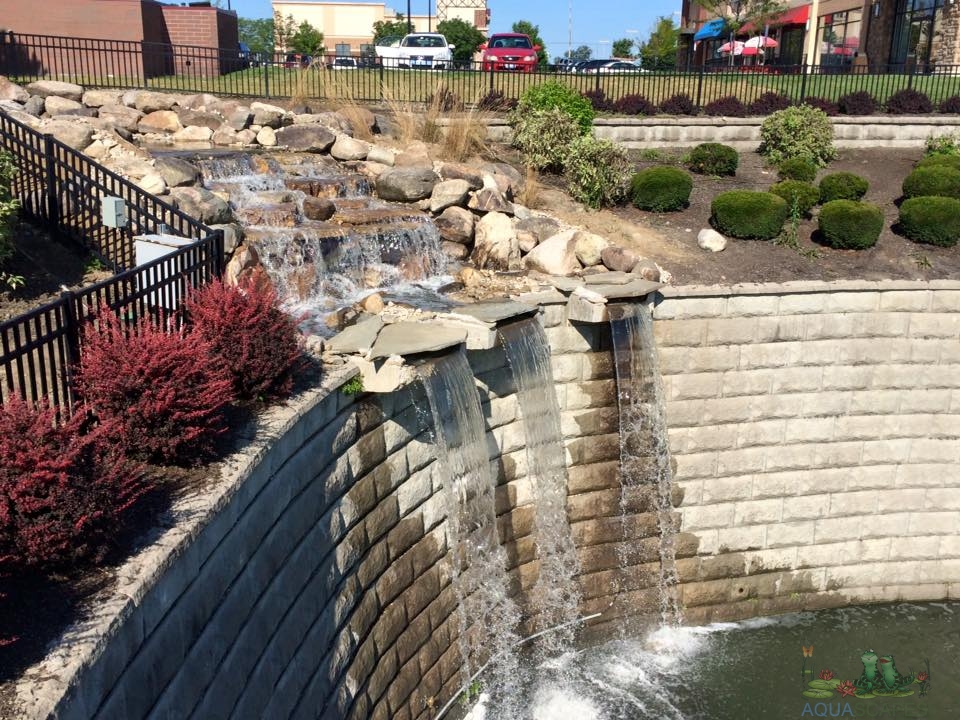
 Meyer Aquascapes
Meyer Aquascapes

